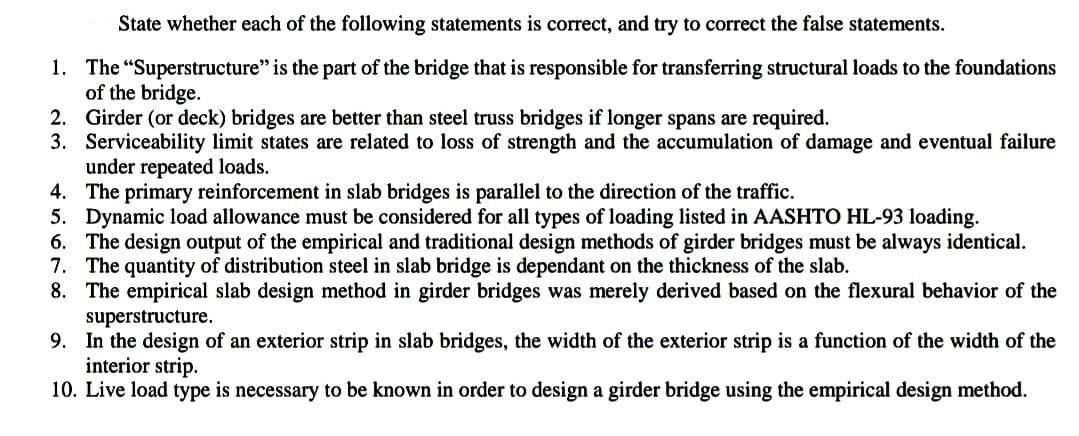State whether each of the following statements is correct, and try to correct the false statements. 1. The "Superstructure" is the part of the bridge that is responsible for transferring structural loads to the foundations of the bridge. 2. Girder (or deck) bridges are better than steel truss bridges if longer spans are required. 3. Serviceability limit states are related to loss of strength and the accumulation of damage and eventual failure under repeated loads. 4. The primary reinforcement in slab bridges is parallel to the direction of the traffic. 5. Dynamic load allowance must be considered for all types of loading listed in AASHTO HL-93 loading. 6. The design output of the empirical and traditional design methods of girder bridges must be always identical. 7. The quantity of distribution steel in slab bridge is dependant on the thickness of the slab. 8. The empirical slab design method in girder bridges was merely derived based on the flexural behavior of the superstructure. 9. In the design of an exterior strip in slab bridges, the width of the exterior strip is a function of the width of the interior strip. 10. Live load type is necessary to be known in order to design a girder bridge using the empirical design method.
State whether each of the following statements is correct, and try to correct the false statements. 1. The "Superstructure" is the part of the bridge that is responsible for transferring structural loads to the foundations of the bridge. 2. Girder (or deck) bridges are better than steel truss bridges if longer spans are required. 3. Serviceability limit states are related to loss of strength and the accumulation of damage and eventual failure under repeated loads. 4. The primary reinforcement in slab bridges is parallel to the direction of the traffic. 5. Dynamic load allowance must be considered for all types of loading listed in AASHTO HL-93 loading. 6. The design output of the empirical and traditional design methods of girder bridges must be always identical. 7. The quantity of distribution steel in slab bridge is dependant on the thickness of the slab. 8. The empirical slab design method in girder bridges was merely derived based on the flexural behavior of the superstructure. 9. In the design of an exterior strip in slab bridges, the width of the exterior strip is a function of the width of the interior strip. 10. Live load type is necessary to be known in order to design a girder bridge using the empirical design method.
Chapter2: Loads On Structures
Section: Chapter Questions
Problem 1P
Related questions
Question

Transcribed Image Text:State whether each of the following statements is correct, and try to correct the false statements.
1. The "Superstructure" is the part of the bridge that is responsible for transferring structural loads to the foundations
of the bridge.
2. Girder (or deck) bridges are better than steel truss bridges if longer spans are required.
3. Serviceability limit states are related to loss of strength and the accumulation of damage and eventual failure
under repeated loads.
4.
The primary reinforcement in slab bridges is parallel to the direction of the traffic.
5. Dynamic load allowance must be considered for all types of loading listed in AASHTO HL-93 loading.
6. The design output of the empirical and traditional design methods of girder bridges must be always identical.
7. The quantity of distribution steel in slab bridge is dependant on the thickness of the slab.
8. The empirical slab design method in girder bridges was merely derived based on the flexural behavior of the
superstructure.
9. In the design of an exterior strip in slab bridges, the width of the exterior strip is a function of the width of the
interior strip.
10. Live load type is necessary to be known in order to design a girder bridge using the empirical design method.
Expert Solution
This question has been solved!
Explore an expertly crafted, step-by-step solution for a thorough understanding of key concepts.
Step by step
Solved in 3 steps with 2 images

Knowledge Booster
Learn more about
Need a deep-dive on the concept behind this application? Look no further. Learn more about this topic, civil-engineering and related others by exploring similar questions and additional content below.Recommended textbooks for you


Structural Analysis (10th Edition)
Civil Engineering
ISBN:
9780134610672
Author:
Russell C. Hibbeler
Publisher:
PEARSON

Principles of Foundation Engineering (MindTap Cou…
Civil Engineering
ISBN:
9781337705028
Author:
Braja M. Das, Nagaratnam Sivakugan
Publisher:
Cengage Learning


Structural Analysis (10th Edition)
Civil Engineering
ISBN:
9780134610672
Author:
Russell C. Hibbeler
Publisher:
PEARSON

Principles of Foundation Engineering (MindTap Cou…
Civil Engineering
ISBN:
9781337705028
Author:
Braja M. Das, Nagaratnam Sivakugan
Publisher:
Cengage Learning

Fundamentals of Structural Analysis
Civil Engineering
ISBN:
9780073398006
Author:
Kenneth M. Leet Emeritus, Chia-Ming Uang, Joel Lanning
Publisher:
McGraw-Hill Education


Traffic and Highway Engineering
Civil Engineering
ISBN:
9781305156241
Author:
Garber, Nicholas J.
Publisher:
Cengage Learning